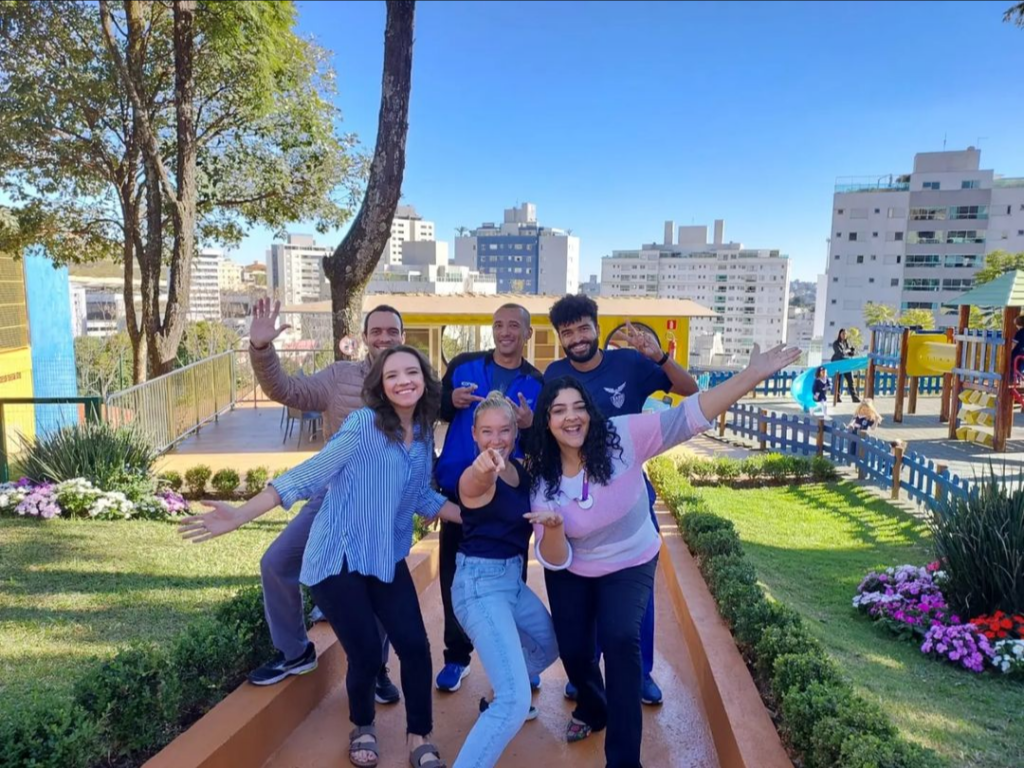Teaching has been my gateway to adventure. Growing up, I heard about my father’s journey as an educator/explorer. In his 20s, he graduated from the University of Victoria and pursued a teaching opportunity in the remote Indigenous community of Igloolik, Qikiqtaaluk Region in Nunavut, northern Canada. He shared stories and videos of the rich cultural immersion, the language barriers, and the challenge of adapting to an entirely different environment. Later, our family completed two year-long teacher exchanges to Australia. These memories inspired me to combine my career with international opportunities.

Nya’s father immersed in the Iglulingmiut, Aivilingmiut, and Tununirmiut Indigenous community wearing caribou fur given by a local family.
When I applied to the University of Victoria’s teaching program, I knew that I eventually wanted to experience diverse teaching employment abroad. The teaching program itself, rooted in the BC curriculum, emphasized developing key aspects of students’ soft skills rather than simply academic success—a perspective that shaped not only my approach to teaching but also my understanding of what it means to be a Canadian teacher.
THE CANADIAN APPROACH
Rooted in Relationships and Multiculturalism
During my teaching practicum, I became deeply influenced by how my mentors approached education. Relationship-building with students came first in Canadian public schools. I learned the value of designing classroom environments where students felt valued and included and where celebrating student successes was central. Canada’s multiculturalism, particularly in BC schools, made the classroom a welcoming space for students from all backgrounds. Every student had at least one adult at school that they connected with, whether that was through sports, clubs, or in class.
My first full-time teaching position was at an International Baccalaureate (IB) private school in the Okanagan area in British Columbia during COVID-19. This opened my eyes to the student-centred approach in international education. As I worked with students from around the world, I realized how much they appreciated the way we celebrated their individuality, empowered their voices, and encouraged incorporating their unique perspectives and experiences.
CROSSING BORDERS
Teaching in Brazil
With my experience teaching in Canada, I decided to transition my skills abroad, and I landed a position at an international IB private school in Belo Horizonte, Brazil. This opportunity was exciting but came with its challenges, especially when it came to cultural adaptation.
The school had a predominantly Brazilian culture, with a few American, Australian, British, and Canadian teachers forming a “gringo” community, offering a sense of familiar camaraderie. However, teaching in Brazil highlighted the significant differences between Canadian and Brazilian classroom dynamics, particularly regarding social interaction and physicality. I was initially taken aback when students frequently wanted to hug me, parents greeted me with cheek kisses, and students were constantly engaging in physical contact with one another. This level of physical closeness contrasted with my Canadian teacher training, which emphasized maintaining physical distance to ensure a safe and professional learning environment. In my previous teaching experience, there was a greater focus on personal space, with limited physical contact, and a stronger emphasis on verbal communication and formality.
BRIDGING CULTURES
Learning Through Empathy

Nya’s first Brazilian school, Escola Americana de Belo Horizonte, Arts Department photo.
Initially, I struggled to grasp the cultural gap between the “cold culture” aura I was unintentionally projecting and the “warm culture” of Brazil. My students were confused and even hurt when I declined their hugs, interpreting it as a refusal to connect. Over time, I realized that in order to create the open and engaging environment I valued, I needed to provide cultural context and build mutual understanding. I explained to my students that, in Canada, we are trained to maintain certain boundaries with students for teacher safety. To my surprise, they responded with empathy and curiosity. This sparked a broader discussion about other cultural differences they had noticed with international teachers. They mentioned how, outside of school, gringo teachers tend to wave rather than embrace and how they often do not share their social media handles with students or parents. This exchange of cultural perspectives became a foundation for fostering empathy and openness in our classroom.
As Canadian educators, we are often taught that it is our responsibility to adapt to students’ needs. While this remains true, I learned that adaptation can go both ways. By opening up a dialogue about my own background, I encouraged my students to reflect on theirs as well. This process built cultural awareness on both sides, fostering an environment where students were not just learning content but also learning how to engage with different perspectives—an essential aspect of global citizenship.
Navigating a Brazilian-Only School
After a couple of years at the international school, I transitioned to an all- Brazilian private school in São Paulo, where I became my students’ first foreign teacher. This time, there was no gringo community to lean on; I was the sole foreigner in the school. All my colleagues and students were Brazilian, and every meeting, email, document, and conversation was in Portuguese.
The initial “gringo effect”—where students were fascinated by my Canadian background—quickly wore off, and I was faced with new behaviour management challenges. My students consistently sought out physical contact from peers, communicated in loud outbursts in indoor spaces, and showed strong desires for socialization, which were constants in the classroom. As I had learned before, relationship-building was key, and I approached these challenges with empathy and flexibility.
Navigating these classroom culture differences required patience and consistent reminders. Opening up to my students about my goals as an educator helped them understand that I was here to expand my experience with the IB program in Brazil and to help inspire students’ English language skills and broaden their future international opportunities. This transparency allowed them to know that I wanted them to be part of my team. My university practicum mentor teacher, Mr. Darren Larose from SD#72, wrote on the whiteboard in one of his classes:
“The individual makes up the collective.” Using this phrase in my classroom helped remind my students to see themselves as a group, as a team, that wanted success for themselves and others. By sharing my “why” with my students, I invited them to identify theirs.
THE CANADIAN ADVANTAGE
Fostering Global Citizenship
Teaching in a new cultural environment helped me appreciate the adaptability and empathy that Canadian educators bring to the classroom. At the core of our teaching philosophy is the belief that every student is unique and capable of success. This belief transcends borders and cultures; each learner wants to be seen and heard, and teachers do, too. Adaptation is not a one-way street. Yes, as a foreign teacher, I’ve had to adapt to my students’ needs and the culture around me. But my students have also learned to adapt to me, to my “cold culture” quirks, and to the Canadian values I bring to the classroom. We’ve grown together, building a learning environment that’s not just about academic success but about understanding and embracing different perspectives.
My time in Brazil has made me a more empathetic and flexible educator. The experiences of cultural immersion—whether navigating a hug-filled hallway or discussing whether snow is wet—have expanded my understanding of what it means to be a teacher. It’s not just about delivering content; it’s about creating a space where students can connect with the world beyond their immediate
surroundings.
Advice for Canadian Teachers Heading Abroad
For Canadian educators considering international opportunities, my biggest advice is to embrace adaptability. Cultural differences will present challenges, but they are also opportunities for growth. Build relationships with your students by sharing your experiences and being open to learning from theirs. Most importantly, trust in the power of the Canadian approach—fostering inclusivity, empathy, and student- centred learning will help you thrive in any classroom.
ABOUT THE AUTHOR
Nya Harle
Nya Harle is originally from Campbell River, BC, and now teaches as an IB DP English Teacher, in Escola Castanheiras São Paulo, Brazil.
This article is featured in Canadian Teacher Magazine’s Fall 2024 issue.









